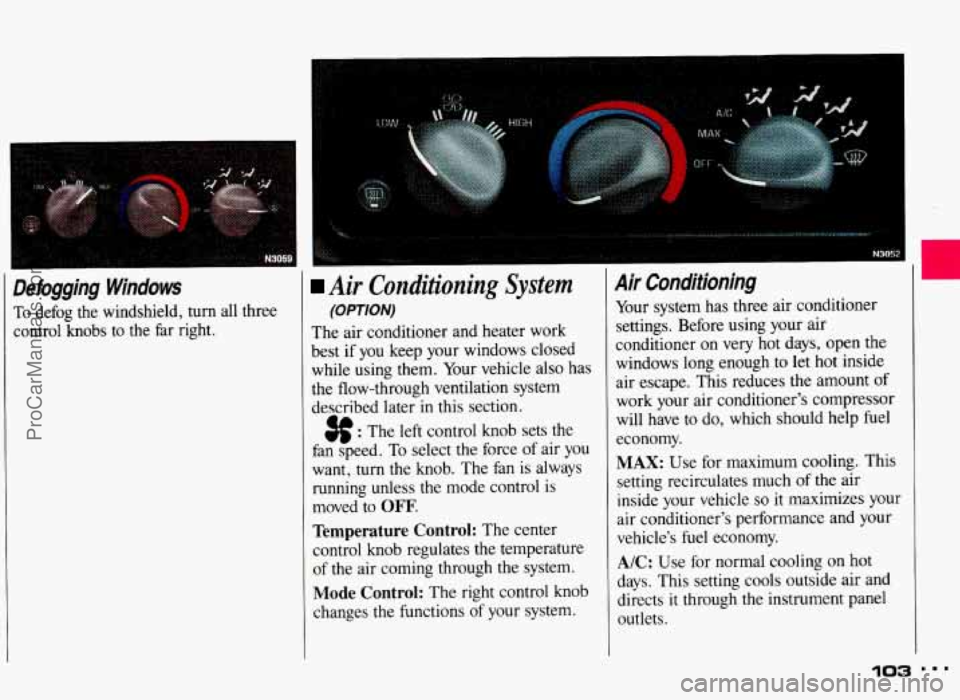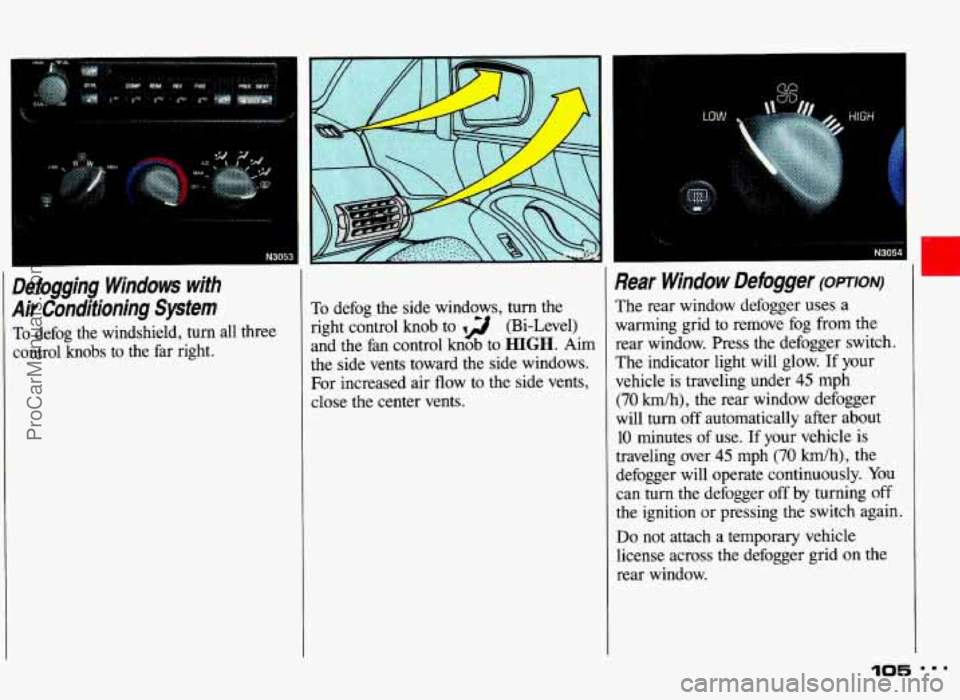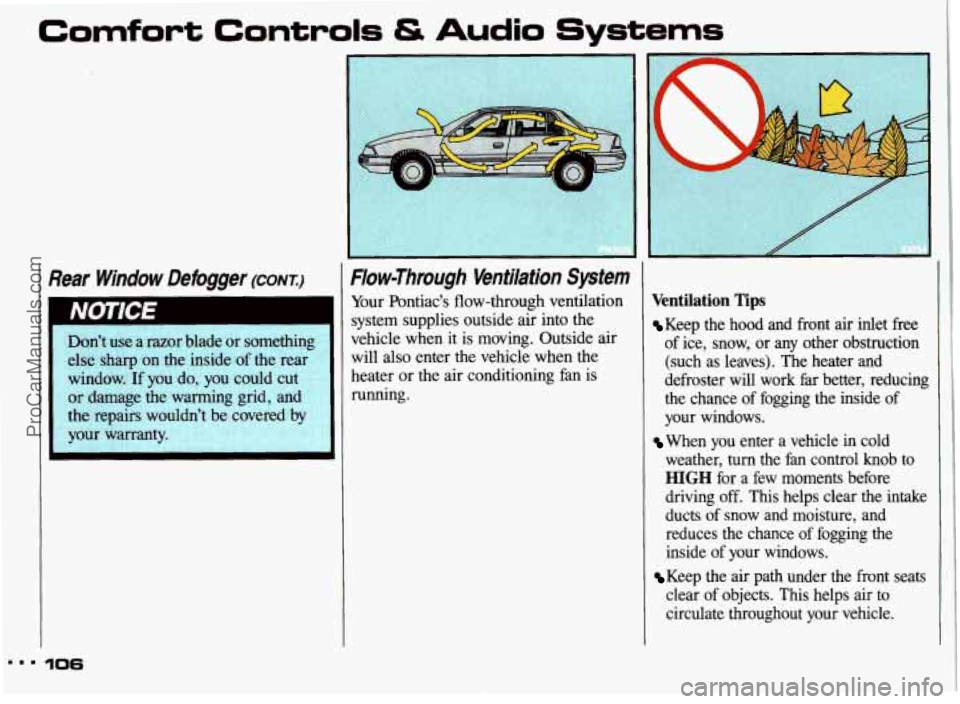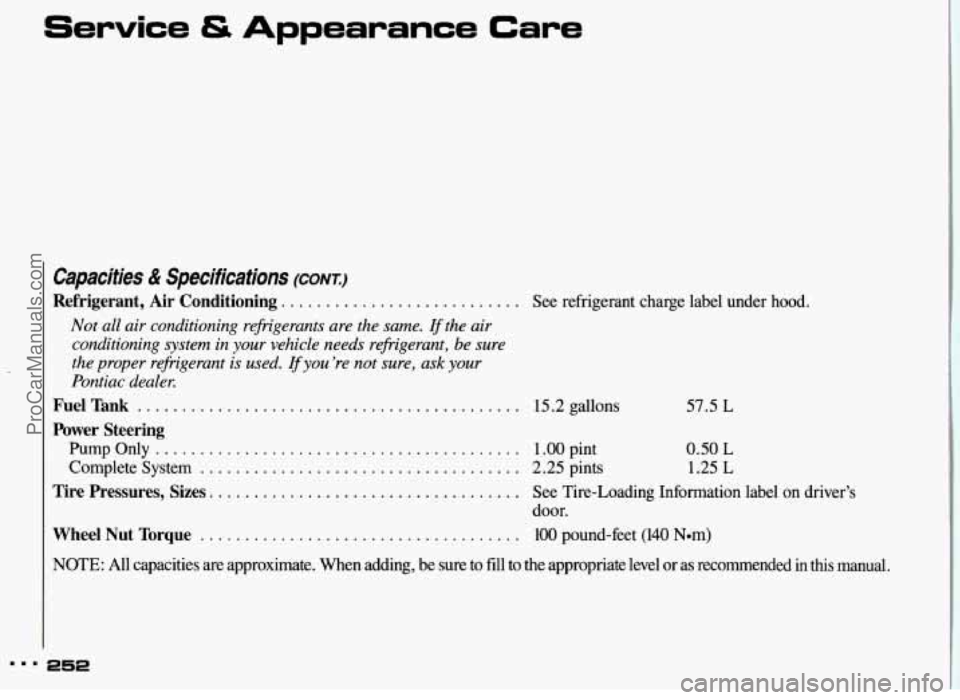1993 PONTIAC GRAND-AM air conditioning
[x] Cancel search: air conditioningPage 102 of 306

Part 3
In this part you’ll find out how to
operate the comfort control systems
and audio systems offered with your
Pontiac
. Be sure to read about the
particular system supplied with your
vehicle
.
Comfort Controls G
Audio Systems =
Climate Control System ............................................ 102
Air Conditioning System ........................................... 103
Setting the Clock ................................................. 107
AM/FM Stereo Radio ............................................. 108
AM/FM Stereo Radio with Cassette Tape Player ......................... 109
AM/FM Stereo Radio with Compact Disc Player ......................... 113
Understanding Radio Reception ...................................... 117
Care of Your Cassette Tape Player .................................... 118
Care of Your Compact Discs ........................................ 118
Power Antenna Mast Care .......................................... 119
AM/FM Stereo Radio with Cassette Tape Player and Graphic Equalizer ....... 111
FixedMastAntenna ............................................... 119
101 m..
ProCarManuals.com
Page 104 of 306

Defogging Windows
To defog the windshield, turn all three
control knobs to the far right.
I
I
Air Conditioning System
(OPTION)
The air conditioner and heater work
best if you keep your windows closed
while using them. Your vehicle also has
the flow-through ventilation system
described later
in this section.
3f : The left control knob sets the
fan speed. To select the force
of air you
want,
turn the knob. The fan is always
running unless the mode control is
moved to
OFF.
Temperature Control: The center
control knob regulates the temperature
of the air coming through the system.
Mode Control: The right control knob
changes the functions
of your system.
Air Conditioning
Your system has three air conditioner
settings. Before using your air
conditioner on very hot days, open the
windows long enough
to let hot inside
air escape. This reduces the amount
of
work your air conditioner's compressor
will have to do, which should help fuel
economy.
MAX: Use for maximum cooling. This
setting recirculates much
of the air
inside your vehicle
so it maximizes your
air conditioner's performance and your
vehicle's fuel economy.
A/C: Use for normal cooling on hot
days. This setting cools outside air and
directs it through the instrument panel
outlets.
103
ProCarManuals.com
Page 105 of 306

Comfort Controls & Audio Systems
Air Conditionina (CONI) -.
qg (Bi-Level): Use on cool, but
sunny days. This setting brings in the
outside air, but directs it in two ways.
The cool air is directed to the upper
portion of your body through the
instrument panel outlets, but slightly
warmer air is directed through the
heater ducts and defroster vents. At
times this temperature difference may be
more apparent than others.
The air conditioner compressor operates
in all three air conditioning positions. It
also operates in (Defrost) when
the outside temperature is higher than
about
40°F (4.5"C).
Ventilation
Use when outside temperatures are
mild, and little heating or cooling is
needed. Turn the right control knob to
2 (Vent). Air flow is directed
through the instrument panel outlets. Set
the center control knob to the
temperature desired.
Heating
Turning the right control knob to
72 (Heater) and the center control
knob clockwise will send heated air
through the heater ducts, and some
through the defroster vents.
3 (Vent) and (Heater) are
economical positions because the air
conditioner compressor doesn't run in
these two settings. This reduces engine
load, resulting in improved fuel
economy. If either setting fails to keep you
comfortable, or causes your windows
to fog up, turn the right control knob to
one of the air conditioning positions, or
to
(j@ (Defrost).
If you have the optional engine block
heater and use it during cold weather,
0°F (-18°C) or lower, your heating
system will more quickly provide heat
because the engine coolant is already
warmed. See the
Index under Engine
Block Heater.
flow equally between the heater ducts
and the windshield defroster vents.
vg (Blend): This setting divides air
Defrosting
The (@ (Defrost) setting directs most
air through the defroster vents, and
some through the heater ducts.
8.8 104
ProCarManuals.com
Page 106 of 306

I
Defogging Windows with
Air Conditioning System
To defog the windshield, turn all three
control knobs to the far right. To defog
the side windows, turn the
right control knob to 12 (Bi-Level)
and the fan control knob to
HIGH. Aim
the side vents toward the side windows.
For increased air flow to the side vents,
close the center vents.
Rear Window Defogger (OPTION)
The rear window defogger uses a
warming grid to remove fog from the
rear window. Press
the defogger switch.
The indicator light will glow.
If your
vehicle is traveling under
45 mph
(70 kmlh), the rear window defogger
will turn off automatically after about
10 minutes of use. If your vehicle is
traveling over
45 mph (70 km/h), the
defogger will operate continuously. You
can
turn the defogger off by turning off
the ignition or pressing the switch again.
Do not attach a temporary vehicle
license across the defogger grid
on the
rear window.
105 ...
................. * N3054
ProCarManuals.com
Page 107 of 306

Comfort Controls & Audio Systems
I
Rear Window Defogger (CONT.:) I Flow-Through Ventilation System
Don’t use a razor blade or something
else
sharp on the inside of the rear
window. If you do,
you could cut
or damage the warming grid, and
the repairs wouldn’t be covered by
your warranty Your Pontiac’s
flow-through ventilation
system supplies outside air into the
vehicle when it is moving. Outside air
will also enter the vehicle when the
heater or the air conditioning fan is
running.
Ventilation Tips
Keep the hood and front air inlet free
of ice, snow, or any other obstruction
(such as leaves). The heater and
defroster will work far better, reducing the chance of fogging the inside of
your windows.
When you enter a vehicle in cold
weather,
turn the fan control knob to
HIGH for a few moments before
driving off. This helps clear the intake
ducts of snow and moisture, and
reduces the chance of fogging the
inside of your windows.
clear of objects. This helps air to
circulate throughout your vehicle.
Keep the air path under the front seats
ProCarManuals.com
Page 250 of 306

Fuse Rating Circuitry
Fuse Usage
HORN
ALARM
HTR-A/C
RDO IGN
TURN
DR LK
TAIL LPS
WDO
WIPER ERLS
FTP
ACC
IGN ECM
HDLP
15
15
25
10
20
20
20
30
25
15
20
30
20
20
Back Up Lights, Electronic PRNDL (automatic transaxle)
Fuel Pump, Fuel Injectors
Turn/Hazard/Stop Lights, Anti-Lock Brakes
(ABS), Brake-
Transaxle Shift Interlock
(BTSI)
Power Door Locks, Power Mirrors, Cigar Lighter
BLANK
Instrument Panel Lights
Rear Window Defogger Relay, Chime, Gages,
ABS , BTSI,
Daytime
Running Lights (Dm) (Canada)
Horn
Chime, Interior Lights, Passive Restraints, Radio/Clock Memory
Heater, Air Conditioning, ABS, DRL (Canada), Engine Block
Heater
Radio, Cruise Control, Variable
Effort Steering
Turn Signals
Power Door Locks
Exterior Lights, Fog Lights, Instrument Panel Lights, DRL
(Canada)
Power Windows (Circuit Breaker)
Windshield WipedWasher
Engine Controls, Starter and Charging System
BLANK
Flash-to-Pass
(US.)
Power Seats, Rear Window Defogger (Circuit Breaker)
BLANK
Engine Control Module, Ignition System
BLANK
Headlights, DRL (Canada) (Circuit Breaker)
ProCarManuals.com
Page 253 of 306

Service & Appearance Care
Capacities & Specifications (CONT.:)
Refrigerant, Air Conditioning. .......................... See refrigerant charge label under hood.
Not all air conditioning refrigerants are the same. If the air
conditioning system in
your vehicle needs refngerant, be sure
the proper refrigerant is used.
If you’re not sure, ask your
Pontiac dealer.
Fuel Tank ......................................... 15.2 gallons 57.5 L
Power Steering
Pump Only ......................................... 1 .OO pint 0.50 L
Complete System .................................... 2.25 pints 1.25 L
Tire Pressures, Sizes. .................................. See Tire-Loading Information label on driver’s
Wheel Nut Torque .................................... 100 pound-feet (140 Nom)
door.
NOTE: All capacities are approximate. When adding, be sure to fill to the appropriate l\
evel or as recommended in
this manual.
... 252
ProCarManuals.com
Page 270 of 306

ITEM
NO. SERVICE
5 Engine Accessory Drive Belt Inspection*-
Inspect the belt. for cracks, fraying, wear and
proper tension. Replace
as needed.
6 Cooling System Service*-Drain, flush and refill
the system with new or approved recycled coolant
conforming to
GM Specification 1825M. Keep
coolant at the proper mixture as specified. See the
Index under Coolant. This provides proper freeze
protection, corrosion inhibitor level and engine
operating temperature.
Inspect hoses and replace if they are cracked,
swollen or deteriorated. Clean the outside of the
surge
tank and air conditioning condenser.
To help ensure proper operation, we recommend a
pressure test
of both the cooling system and the
surge
tank pressure cap.
doesn’t require changing.
7 Transaxle Service-For a manual transaxle, fluid
ITEM
NO. SERVICE
For an automatic transaxle, change both the fluid
and filter every
15,000 miles (25 OOO krn) if the
vehicle is mainly driven under one or more
of these
conditions:
In heavy city traffic where the outside temperature
regularly reaches 90°F
(32OC) or higher.
In hilly or mountainous terrain.
When doing frequent trailer towing. With some
models, you shouldn’t even tow a trailer. See the
Index under Towing a Trailer.
Uses such as found in taxi, police car or delivery
service.
8
9
If you do not use your vehicle under any of
these conditions, change both the fluid and filter
every 100,000 miles
(160 000 km).
Spark Plug Replacement *-Replace spark plugs
with the proper type. See the
Index under
Replacement Parts.
Spark Plug Wire Inspection (3300 V6 Code N
engine)**-Inspect for burns, cracks or other
damage. Check the boot fit at the coils and at the
spark plugs, Replace wires as needed.
ProCarManuals.com